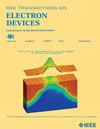利用ct - ffet内禀长短期塑性的轨迹预测系统
IF 2.9
2区 工程技术
Q2 ENGINEERING, ELECTRICAL & ELECTRONIC
引用次数: 0
摘要
轨迹预测是自动驾驶领域的一项重要功能,它依赖于历史信息和当前输入来进行预测。具有动态突触的连续吸引子神经网络(CANN)是进行预测任务的典型算法之一。然而,目前的设备仅限于分别处理静态权重存储和动态调制,导致CANN硬件实现中的资源消耗相当大。在这里,我们利用电荷捕获铁电场效应管(ct - fefet)整合长期和短期可塑性来实现动态突触单元。长期权值存储在铁电域中,而短期权值在CT域中动态运算,消除了外部缓存过程。基于ct - fet固有的长期和短期可塑性,历史信息与原位输入相互作用,促进动态内存计算(IMC),实现实时预测。此外,我们将ct - ffet引入前馈网络和CANN来验证预测性能,并证实了更大的动态范围和更小的短期动态时间常数使系统能够匹配更宽的速度范围进行预测跟踪。这项工作提供了一种使用动态IMC技术执行交互任务的新方法。本文章由计算机程序翻译,如有差异,请以英文原文为准。
Trajectory Prediction System Utilizing the Intrinsic Long-Term and Short-Term Plasticity in CT-FeFET
Trajectory prediction is a vital function in the auto-driving field which relies on both historical information and current inputs to make forecasts. Continuous attractor neural network (CANN) with dynamic synapses is one of the typical algorithms for conducting prediction tasks. However, current devices are limited to separately handling static weight storage and dynamic modulation, leading to considerable resource consumption in the hardware implementation of CANN. Here, we integrate long-term and short-term plasticity using charge-trapping ferroelectric FETs (CT-FeFETs) to realize dynamic synaptic units. The long-term weights are stored in the ferroelectric domain, while the short-term weights are dynamically operated in a CT domain, eliminating the external caching process. Based on the intrinsic long-term and short-term plasticity of CT-FeFETs, historical information interacts with the inputs in situ, facilitating a dynamic in-memory computing (IMC) that enables real-time prediction. Moreover, we introduced CT-FeFET into both feedforward networks and CANN to validate prediction performance, and confirmed that a larger dynamic range and smaller time constant in the short-term dynamics enable the system to match a broader speed range for predictive tracking. This work provides a novel way of performing interacting tasks with dynamic IMC technology.
求助全文
通过发布文献求助,成功后即可免费获取论文全文。
去求助
来源期刊

IEEE Transactions on Electron Devices
工程技术-工程:电子与电气
CiteScore
5.80
自引率
16.10%
发文量
937
审稿时长
3.8 months
期刊介绍:
IEEE Transactions on Electron Devices publishes original and significant contributions relating to the theory, modeling, design, performance and reliability of electron and ion integrated circuit devices and interconnects, involving insulators, metals, organic materials, micro-plasmas, semiconductors, quantum-effect structures, vacuum devices, and emerging materials with applications in bioelectronics, biomedical electronics, computation, communications, displays, microelectromechanics, imaging, micro-actuators, nanoelectronics, optoelectronics, photovoltaics, power ICs and micro-sensors. Tutorial and review papers on these subjects are also published and occasional special issues appear to present a collection of papers which treat particular areas in more depth and breadth.
 求助内容:
求助内容: 应助结果提醒方式:
应助结果提醒方式:


